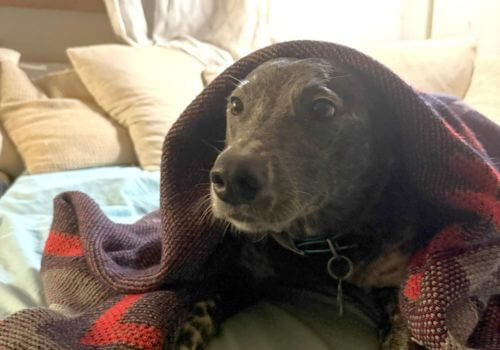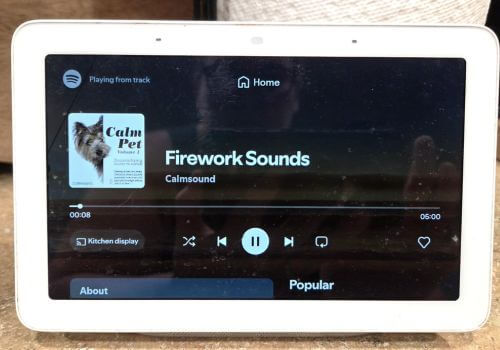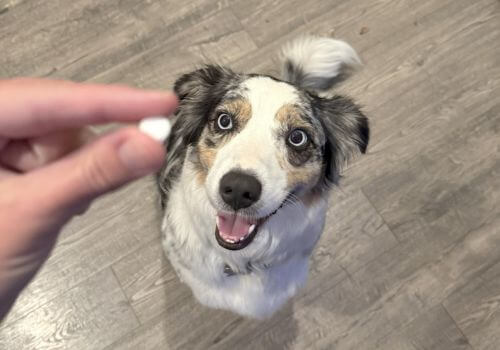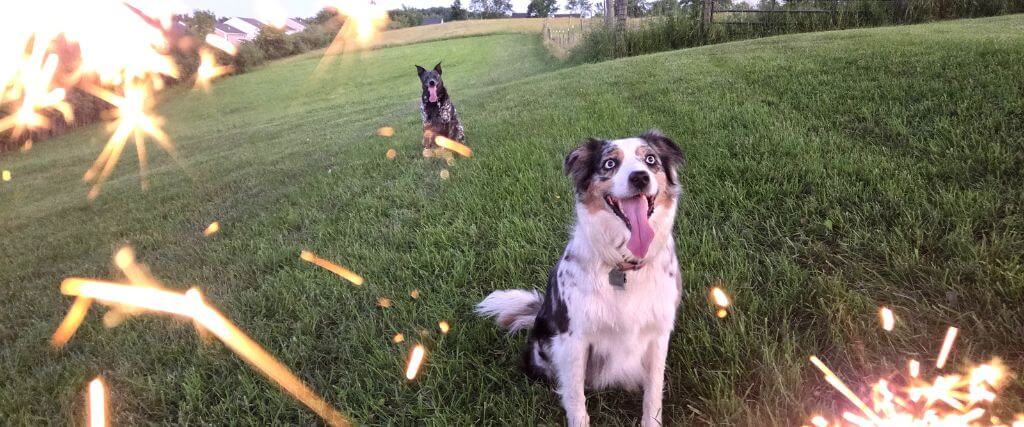The Fourth of July is a holiday filled with backyard BBQ feasts accented by a colorful array of firework explosions enjoyed by many. However, dogs with noise aversion to fireworks and thunderstorms ruin this American pastime. Waking up at 2 a.m. to an 80-lb dog on your chest, hyperventilating from a loud noise, is undesirable to say the least. None of us want our beloved pets to ever be that scared. For many pet owners, the season of fireworks and storms is dreaded, and fireworks can no longer be enjoyed. The escalation of fear to the point of panic must be avoided. Let's explore some ways to counter-condition noise aversion behaviors and have a happier pup during firework festivities and changing weather patterns.
Let's Talk About Dog Behavior
Our pets look to us for reassurance and observe our behaviors to interpret the world around them. Throughout a dog's adolescence, established fear periods will come and go with different developmental stages. If your dog has experienced something that truly scares them, it can have lasting effects. If not supported and redirected, anxiety and general fear are created. Even as adults, new fear behaviors can be established.
According to Daniela Ramos DVM, a behaviorist from Brazil, pets with noise aversion can have two types of resulting fear behaviors: static and active reactions. Static reactions include behaviors such as freezing, trembling, hiding, tucked tail, dilated eyes, and increased panting. Active reactions include behaviors such as excessive barking, running, aggression, and even self-mutilation. Both types of reactions greatly impact their quality of life at that moment and can become life-threatening. Storms and fireworks are most intense at night, and a pet running away disoriented from fear can put them in harm's way.

Help Your Dog Get Used to Life's Loud Moments
Noise phobia is common in dogs, especially because loud sounds are often unpredictable. Research supports the importance of counter-conditioning and desensitization to loud sounds and scary situations. According to the UC Davis College of Veterinary Medicine, your dog is "conditioned" to display an excessive fear response to a stimulus like fireworks or thunderstorms. The plan is to undo their learned behaviors and replace them with appropriate ones; this is termed "counter-conditioning". Let's learn how to retrain your dog's brain!
Building Noise Confidence
Confidence regarding loud sounds can be created, but it takes time and dedication. Start by utilizing music streaming platforms like YouTube, Spotify, Apple Music, and Amazon Music. Smart home devices like Google Home, Amazon Alexa, or Apple HomePod can stream low levels of fear-inducing sounds through your home or in select areas. Do not blare these sounds on your speakers. Make sure the speakers are turned down so it is barely audible. If the volume you start with still makes your pet fearful, turn it down more. You also want to introduce the sounds in short timeframes. Gradually increasing the volume and duration of time will help to desensitize your pet to this stimulus.
According to the UC Davis College of Veterinary Medicine, if your pet shows any signs of fear, do not punish them, but also do not reward the fearful response with extra attention or reassurance. Instead, redirect their concentration to established commands, play routines, or a comforting location. Once the distraction is solidified, provide verbal praise and treat these acceptable behaviors. The goal is to countercondition the animal so that instead of displaying fearful, anxious, and possibly destructive behaviors, they showcase desired behaviors. Playing with their toys, lying in a safe space like their crate, or even showing no response at all shows a pet is comfortable with previous fear-inducing sounds.
"Hey Google, play fireworks sounds on Spotify."
"Alexa, play thunderstorm sounds on Apple Music."

What To Do When The Booms Begin
Don't fret! This is what you have been practicing for. Now is the time to enact the skillsets you have been perfecting. If your pet is still experiencing anxiety during a noise event like fireworks or thunderstorms, use the clinically backed music options by Through A Dog's Ear. This music contains psychoacoustics and is clinically proven to reduce anxiety in your dog. It is easily accessible on music streaming platforms and available in both classical and reggae styles. Pro Tip: If you have smart home devices throughout your home, have the music play on all the speakers to help mask the noises from outside.
"Hey Google, play Through a Dog's Ear on Spotify."
Sometimes, desensitization training and counter conditioning are not enough. Medications such as Trazodone and Gabapentin are often used for acute anxiety situations. For best results, it is recommended to give these medications two hours ahead of time. Some pets metabolize medications differently and need different dosages. Do not wait to try them out. Also, some pets can override medications based on the severity of their anxiety and stress, so they may need a higher dose to compensate for that. Keep in mind that some patients exhibit signs of aggression while taking these medications.

Training Calmness, One Sound At A Time
Through patience and practice, your pet can have a better experience when faced with noise-phobia-inducing situations. Behavioral changes will not happen overnight; it takes time and dedication to your pet to modify their behaviors using positive reinforcement. As mentioned above, training alone may not be enough. Schedule an appointment with your veterinarian to talk about anxiety medication options. Make sure to keep your pet safe during these stressful events. When you take them outside, always have them on a leash with up-to-date information on their collar and current microchip details. Utilize your pet's cozy safe place for extra reassurance when triggers occur. As always, please let us know if you have any questions or concerns about noise phobias and your dog. Scheduling a consultation with your veterinarian allows them to create a tailored treatment and training plan with you so that together, we can help your pet have freedom from their fear.
If you have questions and you'd like to reach out to us, you can call us directly at (703) 273-2110, or you can email us at [email protected]. Don't forget to follow us on social media Facebook, Instagram.

